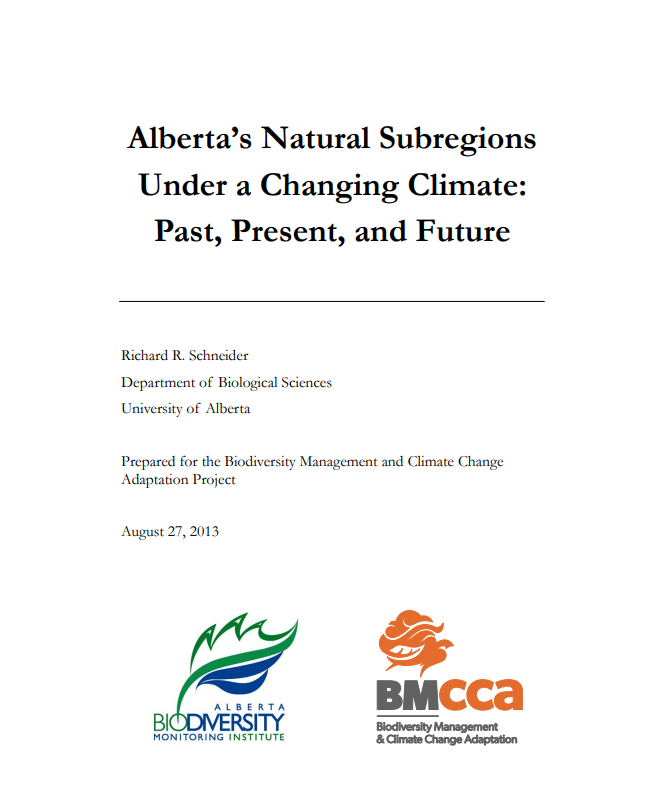Article /
Alberta’s Natural Subregions Under a Changing Climate: Past, Present, and Future

Executive Summary
This resource was submitted by the Climate Risk Institute for use by the CanAdapt Climate Change Adaptation Community of Practice.
This article is an abridged version of the original text, which can be downloaded from the right-hand column. Please access the original text for more detail, research purposes, full references, or to quote text.
The Natural Regions and Subregions classification represents the state-of-the-art in ecological land classification in Alberta. This classification provides a valuable baseline for resource management and conservation planning in the province. It is becoming increasingly apparent, however, that current landscape patterns are destined to change in coming decades as a consequence of global warming. In this report I place the Natural Regions and Subregions into a dynamic framework, describing how they have responded to climate change in the past and how they are expected to change over the next hundred years. Understanding how Natural Regions and Subregions will change over time will improve conservation planning and facilitate adaptation efforts.
The Past Temperatures in Alberta have been both far colder and far hotter than those we currently experience. The warm climate of the Hypsithermal period (4,000-8,000 years ago) is of particular interest because the ecological patterns of that time can be reconstructed using sediments from lakes and ponds across the province. Most studies suggest that Hypsithermal summer temperatures in Alberta were 1.5-3 °C warmer than at present, which is on the low end of what is expected later this century as a result of global warming. Conditions were also substantially drier at that time, reflecting the combined impact of increased evapotranspiration from higher temperatures and reduced precipitation. Winter temperatures during the Hypsithermal were colder than what is expected for the future, so the Hypsithermal should not be considered a perfect analog for the future climate. Nevertheless, it is the climate during the summer growing season that is most important ecologically.
Reconstructions of Hypsithermal vegetation suggest that Natural Subregions generally shifted one Subregion northward relative to their present distribution. In the Boreal, there is clear evidence of a conversion of Dry Mixedwood to Central Parkland. There is also evidence of a transition of Central Mixedwood to Dry Mixedwood, at lower elevations. Higher elevation sites in the Boreal remained stable during the Hypsithermal. Pollen records from the Grassland and Parkland are very limited, so it is not known how species composition changed in these Regions during the Hypsithermal. We do know that most lakes were dry, even in the Parkland, which suggests that little more than a dry grassland could have been supported. Evidence of increased aeolian activity implies that active sand dunes were present, and vegetation may have been sparse in some areas. Compared to the Boreal and Grasslands, the Foothills and Rocky Mountain Regions were relatively stable during the Hypsithermal. There is evidence of upslope movement of tree species, and in some areas there was an increase in the proportion of pine, together with an increase in the rate of fire. The water table decreased, but lakes did not become saline or dry out.
The Present Mean annual temperature (MAT) is inversely related to latitude and elevation. The spatial pattern is fairly simple, with the mountains and Boreal hill system providing the only significant variations in an otherwise uniform north-south gradient.
Precipitation is highest in the mountains and foothills, where it increases fairly uniformly with elevation. In the rest of province, the highest rates of precipitation are found at mid latitudes and decline as one moves north or south. The northern boundary of Wood Buffalo National Park receives about the same amount of precipitation as Medicine Hat.
The amount of moisture that is available to plants is a function of both temperature and precipitation. Increased temperature causes an increase in the rate of evapotranspiration, which dries out the soil. The Climate Moisture Index (CMI) provides an index of the amount of available moisture on an annual basis. In the southern half of the province CMI increases rapidly with latitude. In the north, CMI is relatively uniform across very large areas, with the notable exception of the hill system. The hills are both cooler and wetter than the surrounding lands and have significantly higher CMI values.
These broad climatic patterns are responsible for most of Alberta’s ecological diversity when viewed at the regional scale. Factors other than climate, such as soil type, topography, and disturbance history, become increasingly influential in determining ecosystem type as one moves from the regional scale to the local scale. Subregions represent an intermediate scale — climate is generally the dominant factor in determining Subregion type, but not in all cases.
Bioclimatic envelope models statistically define the unique climate space, or ―envelope‖, of individual ecosystems, based on current eco-climatic associations. Once developed, these models can be used to predict ecosystem type given the future climate as an input. This is the most commonly used approach for predicting changes in the distribution of ecosystems resulting from global warming.
I constructed a suite of bioclimatic envelope models to define the climate space of Alberta`s Subregions, using the mean climate from1961-1990 as the baseline. I limited the development of these models to Subregions for which evidence exists of a strong causal relationship between climate and ecosystem type. These Subregions fall into two main groups: Subregions that are primarily influenced by moisture limitation and Subregions that are primarily influenced by the climatic changes associated with rising elevation. In both groups the Subregions represent points along an ecocline. The Northern Mixedwood Subregion is another climate-associated ecosystem, but it does not belong to either of the previous two ecoclines. The climate envelope in this case was based on a proxy for the presence of permafrost, the defining feature of this Subregion.
Three Subregions in northeast Alberta — the Kazan Upland, Athabasca Plain, and PeaceAthabasca Delta — experience a boreal climate but are vegetatively quite distinct from the adjacent Central Mixedwood. Unique parent materials are primarily responsible for the distinct vegetation patterns in the Kazan Upland and Athabasca Plain (Precambrian granite and sandstone, respectively). In the case of the Peace-Athabasca Delta it is the extensive delta that is responsible for the unique vegetation patterns. The overriding influence of non-climatic factors on vegeta-tion patterns in these three Subregions means that bioclimatic envelope modeling could not be used for these areas.
Future Climatic Patterns The climate data for this study were obtained from the ClimateWNA model, which provides downscaled climate data from 24 General Circulation Models (GCMs) used in the Intergovernmental Panel on Climate Change Fourth Assessment. Projections are provided for three 30-year time periods: 2011–40, 2041–70, and 2071–2100 (hereinafter referred to as 2020s, 2050s, and 2080s). Various greenhouse gas emission scenarios are available for each model, and for this study I focused on the high emission A2 scenario and the low emission B1 scenario. Averaging across all models, the MAT for Alberta is projected to rise by 4.2 °C by the end of the century under the high-emission A2 scenario, and 2.8 °C under the more restrained B1 scenario. None of the models projects an increase of less than 2.0 °C. Accompanying this increase in temperature is an associated 33-56% increase in growing degree-days, which comes largely as a result of an earlier onset of spring. The average increase in mean annual precipitation (MAP) across all models is 9.4% for the A2 scenario and 7.2% for the B1 scenario. None of the models predicts a decline in MAP. Although overall annual precipitation is projected to increase, most models predict a decline during the summer months. The average decline is 2.4% in July and 6.5% in August for the A2 models and 0.2% in July and 2.3% in August for the B1 models.
Although overall precipitation is projected to increase, most climate models predict that Alberta will become substantially drier in the coming decades. Averaging across all models, CMI decreases from a historical norm of 5.9 cm to -5.1 cm under the A2 scenario and to -0.6 cm under the B1 scenario. The main reason for this decline is that warmer temperatures increase the rate of evapotranspiration from soils and vegetation. In addition, the duration of winter snow cover will be shortened, leading to earlier ground warming and a longer period of evaporative moisture loss. Finally, although total precipitation is projected to increase, precipitation during midsummer, when moisture stress is greatest, is expected to decline.
Future Ecological Patterns For the detailed analysis of ecological patterns I focused on five GCM-scenario combinations, selected to represent the full range of potential climate outcomes. For readability I labelled these five models on the basis of the defining feature of each: Cool, Median, Hot, Dry, and Wet. The modeling results suggest that there are two main climate trajectories that need to be considered: dry and wet.
The dry trajectory, which is most likely, involves GCMs in which the effects of increased temperature predominate. Increased evapotranspiration from higher temperatures overwhelms any increases in precipitation that may occur, leading to progressive drying of the landscape relative to historic conditions. The Cool and Hot models are representative of minimum and maximum amount of change expected on this trajectory and the Median model represents an intermediate case.
Under the wet climate trajectory, represented by the Wet model, the effects of increased precipitation predominate. Only three GCMs support this outcome, suggesting that it is not likely. Succession under a climate that is both hotter and wetter is difficult to predict because it implies a transition to a climate space that does not currently exist in Alberta. Species from warmer climes would eventually arrive, but major shifts in ecological composition are not likely before the end of the century. This trajectory is not considered in any detail in this report.
Citation: Schneider, R.R. (2013, August). Alberta’s Natural Subregions Under a Changing Climate: Past, Present, and Future.
